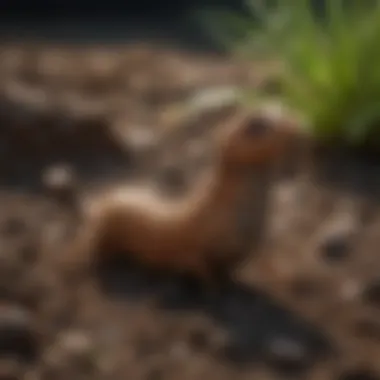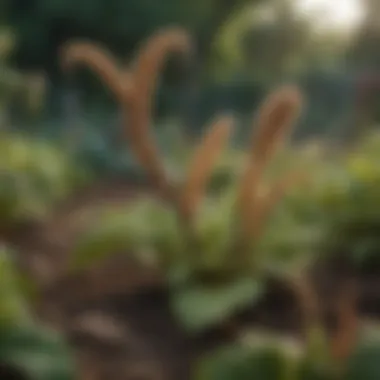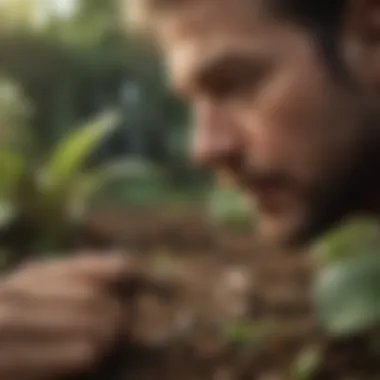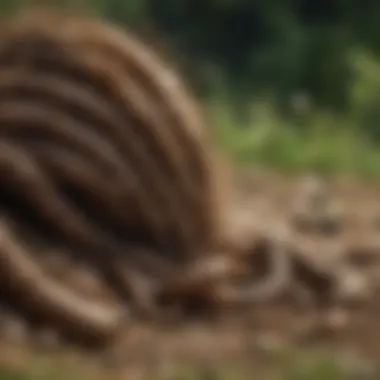Understanding and Managing Cutworms in Your Garden


Overview of the Topic
Definition and Importance
Cutworms are the larval stage of certain moths, primarily belonging to the Noctuidae family. They reside beneath the soil surface, often close to the base of plants. This allows them to feed on developing seedlings, causing significant damage in a garden setting. Understanding this pest is crucial for gardeners, whether they are cultivating vegetables, flowers, or ornamental plants. The impact of cutworms can lead to reduced yields and compromised plant health.
Current Trends
In recent years, there has been a growing focus on sustainable gardening practices. As organic gardening gains popularity, an understanding of pest management, including cutworms, becomes increasingly relevant. Gardeners are exploring methods that minimize chemical use while effectively controlling these pests. This shift underscores the importance of educational resources that promote ecological approaches.
Key Techniques and Practices
Step-by-Step Guide
- Identify Cutworm Damage: Look for signs such as cut-off seedlings and chewed stems at the soil line.
- Monitor Soil Temperature: Cutworms thrive in warmer soils. Use a soil thermometer to track temperatures and such avoid planting too early.
- Cultural Practices: Rotate crops each year to disrupt cutworm life cycles. Consider planting crops that are less attractive to them.
- Physical Barriers: Use collars made of cardboard or tin foil around seedlings to protect them. Bury the collar about an inch deep.
- Natural Predators: Encourage beneficial insects such as birds and parasitic wasps that prey on cutworms.
Tools and Equipment Needed
- Soil thermometer
- Cardboard or tin foil for collars
- Hand trowel or spade for planting
- Mulching materials to deter cutworm emergence
Challenges and Solutions
Common Obstacles
- Limited Awareness: Many gardeners may overlook early signs of cutworm activity.
- Timing of Interventions: Not applying management strategies at the right time can exacerbate damage.
Innovative Solutions
- Education and Resources: Engage in local gardening workshops or online forums to learn about cutworm management. Websites like Wikipedia and Britannica can provide valuable insights.
- Companion Planting: Pair plants that deter cutworms with those that are susceptible. For example, marigolds can repel various pests, including cutworms.
"Effective management of cutworms involves both observation and proactive strategies that promote a balanced ecosystem."
By implementing the strategies discussed, gardeners can better defend their crops against cutworm infestations, ensuring the healthy growth of their plants.
Preamble to Cutworms
Understanding cutworms is essential for every gardener and farmer. These pests can cause significant damage to various crops, affecting their growth and yield. Knowledge about cutworms helps in developing effective management strategies to protect valuable plants. Farmers and garden enthusiasts who grasp the biology and habits of cutworms are more likely to minimize their impact.
Definition and Species Overview
Cutworms are the larvae of nocturnal moths, belonging primarily to the Noctuidae family. Their name derives from their habit of cutting down young plants at the base. Notably, there are several species of cutworms, including the Agrotis ipsilon, commonly known as the black cutworm, and the Feltia jacobaeae, or the yellow cutworm. Each species has distinct characteristics, affecting the type of plants they prefer and the damage they inflict. Awareness of these species enables gardeners to take specific preventative measures based on the variety of cutworms they may encounter.
Life Cycle and Habits
The life cycle of cutworms typically consists of four stages: egg, larva, pupa, and adult moth. The adult moths lay eggs in the soil or on foliage during the warmer months. After about a week, the larvae emerge. Cutworm larvae can reach a size of about 2 inches and usually exhibit color variations, ranging from gray to brown, which aids in their camouflage within the soil or among plants.
Cutworms are primarily nocturnal, feeding under the cover of darkness. They tend to stay close to the soil, making them somewhat difficult to spot. These habits underscore the importance of regular inspections and monitoring for signs of infestation. Understanding their behavior is crucial for implementing timely interventions to protect crops.
Identifying Cutworms in the Garden
Identifying cutworms in the garden is crucial for effective pest management. Early detection of cutworms can save valuable crops from significant damage. Understanding their physical characteristics and signs of infestation allows gardeners to take proactive measures. Knowledge in this area minimizes losses and promotes healthy crop growth. Cutworms are nocturnal and can be elusive, making identification a key step in managing their presence in gardens.
Physical Characteristics
Color Variations
Cutworms exhibit a range of color variations, which can range from brown, gray, to green shades. This variability often depends on their species and their surrounding environment. Understanding these color variations is vital for gardeners as it helps them identify which species they are dealing with. Each color can provide camouflage in the soil, making it challenging to notice them until damage is done. Recognizing these colors can also aid in implementing targeted control methods.
One specific feature of color variations is that brighter colors typically indicate younger larvae, while darker colors often signify maturity. This distinction can help in estimating their presence in the garden. If you encounter light green or yellowish cutworms, they are more likely to be younger and can cause alarm with their voracious eating habits.
Size Dimensions
Size dimensions in cutworms can vary considerably, averaging about one to two inches long in the larval stage. Knowing their size is important since it helps in verifying sightings. Smaller cutworms tend to be more active and can feed on tender seedlings, while larger ones may cause damage to more established plants.


A unique feature of their size is the thickness of the cutworm's body, which can be mistaken for a dried stem or twig. This can lead to underestimating their presence. For effective identification, gardeners can measure the length and assess how it corresponds to visible damage on plants.
Signs of Infestation
Cut Plants
The presence of cut plants serves as a clear sign of cutworm activity. Cutworms often sever young plants at the base, leaving them wilted or entirely uprooted. Recognizing this type of damage is essential for determining if cutworms are the culprits behind plant loss. Their feeding pattern tends to create a distinctive cutting action that gardeners should be aware of.
Understanding this sign allows gardeners to make immediate assessments and take counter-measures. However, it is essential to confirm that other pests are not contributing to the problem.
Presence of Frass
Frass, which is the excrement of cutworms, often accompanies their feeding activities. Identifying frass can provide supplementary evidence of cutworm presence. The small, granular droppings are usually found near damaged plants and can indicate the scale of the infestation. Monitoring frass is advantageous as it helps pinpoint areas where cutworms are actively feeding.
Overall, knowing how to identify cutworms through their signs and characteristics enables gardeners to act before the situation escalates. As a reminder, vigilance during regular garden inspections contributes significantly to the overall success of crop management.
Cutworm Damage to Crops
Cutworms have the potential to cause significant damage to crops, making understanding their impact essential for gardeners and farmers. This section focuses on how cutworms affect both seedlings and established plants, providing insight into the nature of their damage. Recognizing these effects helps in implementing timely preventive measures.
Types of Damage
Seedlings
Seedlings are particularly vulnerable to cutworms. These young plants are the foundation of the garden or farm, as they represent the next generation of crops. Cutworms can sever seedlings at the base during their feeding habits, leading to complete loss. This is troubling because the early stages of growth are crucial for the establishment of a healthy harvest.
One key characteristic of seedlings is their delicate and tender structure. As a result, they lack the resilience of more developed plants. The nutritional demands and higher moisture content make them even more attractive to cutworms. Furthermore, the consequences of seedling damage extend beyond the immediate loss; they can disrupt growth cycles and delay harvest timelines. This makes managing cutworm populations to protect seedlings an essential consideration for anyone invested in gardening.
Established Plants
Established plants also fall prey to cutworms, albeit in different ways than seedlings. These plants have stronger stems and developed root systems, but they can still suffer serious harm. Cutworms may chew through their stalks or bark, creating wounds that invite disease and other pests. This kind of damage can ultimately weaken the plant's health and productivity.
A key characteristic of established plants is their ability to recover from stress to some extent. However, the stress inflicted by cutworms can lead to stunted growth and reduced yields. Established plants are often seen as a more resilient choice in the garden. Nevertheless, even these can be overwhelmed by a severe infestation. An infestation of cutworms affecting established plants demands quick action to mitigate long-term impact on the crop.
Impact on Crop Yield
The impact of cutworms on crop yield can be profound. When both seedlings and established plants suffer damage, it reduces the overall productivity of the garden or farm. A few cutworms can result in extensive losses that affect financial viability.
- Loss of seedlings means that there are fewer plants to mature into harvestable crops.
- Damaged established plants may fail to produce expected yields due to compromised health.
Timely identification and intervention can significantly mitigate the risks posed by cutworms.
Preventative Measures
Preventing cutworm infestations in your garden is essential for maintaining healthy crops. These measures can save time, effort, and resources that may otherwise be spent dealing with damage caused by these pests. Understanding the importance of preventative strategies will empower gardeners to take steps that ensure better crop yield and sustainability.
Soil Management Techniques
Crop Rotation
Crop rotation involves changing the type of crop grown in a particular area each season. This method disrupts cutworm life cycles, reducing their population over time. The key characteristic of crop rotation is its ability to break pest cycles. By alternating crops, gardeners can prevent cutworms from becoming established in the soil. This practice is beneficial because it improves soil health and reduces the likelihood of soil-borne diseases.
A unique feature of crop rotation is that it not only targets cutworms but also benefits the overall ecosystem. For instance, planting legumes can enrich soil nitrogen, helping future crops. However, the challenge lies in remembering to rotate crops continually, which requires planning and organization.
Proper Soil Aeration
Proper soil aeration is crucial for healthy root systems and soil structure. Cutworms thrive in compacted soil, which can restrict airflow and moisture. The key characteristic of proper aeration is improved drainage, allowing roots to access the nutrients they need. This method is popular among gardeners because it enhances plant health and resilience against pests.
A unique feature of aeration is its impact on the microbial ecosystem within the soil. By improving soil structure, beneficial microbes can flourish, creating an environment less favorable for cutworms. One possible downside is that excessive aeration can disrupt established roots if not done carefully. Thus, it's essential to find the right balance to reap the benefits without harming the plants.
Cultural Practices
Timing of Planting


Timing of planting is a crucial factor in managing cutworm populations. Planting early in the season before cutworms emerge can reduce their impact on young seedlings. The key characteristic of this practice is its ability to synchronize planting with pest cycles, minimizing risk. This method is beneficial since it allows crops to establish before pests become active.
A unique feature of timing is that it often depends on local climate and specific crop types. Understanding local conditions can help gardeners optimize planting schedules. While early planting is advantageous, there remains the risk of late frosts or other adverse weather affecting young plants. Therefore, careful consideration is needed.
Spacing Considerations
Spacing considerations can also play a role in managing cutworms. Providing adequate space between plants helps ensure better airflow and reduces the likelihood of pests affecting multiple plants. The key characteristic of proper spacing is that it creates an environment less conducive to pest infestations. This practice is popular because it contributes to healthier plant growth.
A unique feature of spacing is its adaptability. Gardeners can adjust spacing based on plant growth habits and local conditions. Although proper spacing can limit competition for resources, it can also lead to some areas remaining underutilized. Consequently, gardeners should evaluate their planting strategies to maximize space while ensuring healthy plant development.
Effective preventative measures make a significant differnce in the management of cutworm populations in gardens. Investing time in these strategies will lead to more fruitful and sustainable gardening practices.
Control Strategies
Effective control strategies are essential for managing cutworms in any garden. These methods aim to reduce the population of cutworms while minimizing damage to crops. Employing both organic and chemical controls can lead to a healthier garden ecosystem. Understanding the pros and cons of these strategies provides gardeners the ability to choose the best approach for their specific circumstances.
Organic Control Options
Handpicking
Handpicking is a simple yet effective method of controlling cutworm populations. This strategy requires gardeners to manually remove the worms from the soil or plants during early morning or late evening when they are most active. The main advantage of handpicking is that it is a non-toxic solution, making it safe for both plants and beneficial insects.
The unique feature of handpicking is its immediate impact on cutworm numbers. By physically removing these pests, gardeners can see a significant decrease in infestations. However, this method can be labor-intensive and may not be feasible for large gardens. Nonetheless, for small plots, handpicking remains a popular choice.
Nematodes
Nematodes are microscopic roundworms that can be deployed as a biological control option against cutworms. They seek out and infect cutworms, leading to their demise. This method is particularly appealing because it targets the pests without harming beneficial organisms in the soil.
The key characteristic of nematodes is their ability to reproduce within the pest, offering a sustained control measure. Applying them is straightforward; they are mixed with water and applied to the soil. The advantage of using nematodes is their effectiveness in a variety of environmental conditions. However, they may require specific conditions for optimal performance, such as proper moisture levels in the soil, making monitoring key.
Chemical Control Methods
Selective Insecticides
Selective insecticides can be an effective chemical control method against cutworms. These products specifically target the pests while preserving beneficial insects. This characteristic makes them a valuable tool for maintaining an ecological balance within the garden.
One advantage of selective insecticides is their rapid action in eliminating cutworms. They usually work quickly, often within a day or two. However, the potential downside is that over-reliance on chemicals can lead to resistance among pest populations over time, making it crucial to use this method judiciously.
Application Tips
Proper application is vital when using any chemical control. Timing and technique influence the effectiveness of the treatment. Applications should occur during cool, overcast days to prevent the rapid evaporation of the chemicals.
The unique feature of these application tips lies in the maximization of effectiveness while minimizing negative impacts on the environment. Gardeners should adhere to label instructions for the best outcomes. However, caution is warranted; misuse of insecticides can lead to harm to non-target species or environmental contamination. Thus, applying chemicals responsibly is paramount for sustainable gardening practices.
"Using a combination of different control strategies can enhance the effectiveness and sustainability of pest management in your garden."
Biological Control Agents
Biological control agents play a crucial role in managing cutworm populations in gardens. These natural methods often reduce the need for chemical pesticides, aligning with sustainable gardening practices. Understanding how to utilize these agents can significantly benefit gardeners looking to maintain a healthy ecosystem while effectively controlling pests.
Natural Predators
Birds
Birds are among the most effective natural predators of cutworms. They actively search for larvae in the garden, helping to keep their numbers in check. Notably, many bird species are adapted to consume soft-bodied insects, which includes cutworms.
A distinct advantage of leveraging birds for pest control is their ability to cover large areas quickly, providing an extensive reach within your garden. Some of the best avian predators include swallows, robins, and wrens, which not only help control cutworm populations but also enhance the overall biodiversity of the garden.
However, there are some considerations. Encouraging birds necessitates creating a suitable environment that provides food, nesting sites, and protection. This can take time and planning, but the long-term benefits can be significant.
Beneficial Insects
Beneficial insects, such as predatory beetles and parasitic wasps, also contribute to the control of cutworm populations. These insects prey on cutworm larvae or deposit their eggs within them, leading to reduction in pest numbers.


The key characteristic of beneficial insects is their specific targeting of harmful species without affecting other beneficial organisms in the garden. For instance, the larvae of lacewings are known to consume various pest larvae, including cutworms. This makes them an excellent choice for integrated pest management.
One unique feature of beneficial insects is their ability to reproduce quickly. This means once they establish a presence in the garden, they can help maintain pest control over time. Nevertheless, it is essential to monitor the balance of the ecosystem as introducing certain insects can lead to unexpected changes.
Companion Planting
Companion planting involves cultivating specific plants together to enhance growth and repel pests. Certain plants, such as marigolds and garlic, can deter cutworms naturally. This method not only reduces pest problems but also promotes soil health and biodiversity.
By selecting the right companions, gardeners can create a harmonious environment that optimally supports plant health while minimizing the presence of cutworms. This approach emphasizes a holistic understanding of gardening that benefits both plants and their caretakers.
Monitoring and Evaluation
Effective management of cutworms hinges on diligent monitoring and evaluation. Gardeners must adopt systematic strategies to minimize cutworm populations and protect their crops. This practice enables early detection of potential infestations, making it possible to implement timely control measures. Regular assessment not only reveals the presence of cutworms but also provides insights into their life cycle and habits, which can vary significantly based on environmental factors.
Regular Garden Inspections
Regular garden inspections are vital in the fight against cutworms. Conducting these inspections allows gardeners to identify cutworm activity before it leads to severe crop damage. Aim to check your garden at least once a week, and increase the frequency during the peak growing season.
What to Look For:
- Signs of Damage: Look for cut plants at their base, often at soil level.
- Frass: Identify small, pellet-like droppings that indicate cutworm presence.
- Soil Disturbance: Check for any unusual disturbances in the soil around plants, which could signal cutworm activity.
Incorporate a transect method while inspecting. Moving systematically across your garden helps ensure no plants are overlooked. If you find evidence of cutworms, action should be taken immediately to minimize damage.
Record Keeping
Record keeping plays a crucial role in monitoring the effectiveness of your management strategies. By documenting findings from your inspections, you can track trends in cutworm populations and analyze patterns over time. This data helps refine your approach, making it possible to adapt your tactics based on what is working and what is not.
Suggested Records to Keep:
- Inspection Dates: Detail when each inspection occurs.
- Observations: Note any signs of cutworm activity or damage found.
- Control Measures Implemented: Record any actions taken against cutworms, such as organic controls or chemical treatments.
- Results: Track the outcomes of various strategies. Were infestations reduced? Did certain methods prove more effective?
Maintaining organized records also aids in communication with other gardeners and agricultural experts. Sharing insights can foster collaboration and contribute to more effective solutions for managing cutworms in the wider gardening community.
The End
The conclusion of this article emphasizes the importance of understanding and managing cutworms for effective gardening. Cutworms can cause significant damage to young plants, leading to challenges for both amateur and professional gardeners. Addressing these pests is crucial in protecting the investments in time, labor, and resources that gardeners dedicate to their crops. By implementing the strategies discussed in previous sections, gardeners can create a sustainable approach to managing cutworms while maintaining a healthy garden ecosystem.
Recap of Key Points
To summarize the essential aspects covered in this article:
- Definition and Species of Cutworms: Understanding what cutworms are and the different species helps in effective identification.
- Identifying Signs of Infestation: Recognizing physical traits and symptoms of plant damage can lead to quicker intervention.
- Impact on Crop Yield: Cutworms primarily affect seedlings and established plants, which can lead to decreased productivity.
- Prevention and Control Strategies: Integrating organic and chemical control methods offers a multifaceted approach.
- Biological Control Agents: Natural predators and companion planting can help manage cutworm populations sustainably.
- Monitoring Procedures: Regular inspections and accurate record-keeping are crucial in assessing the effectiveness of control measures.
Final Recommendations
Based on the information presented:
- Implement Integrated Pest Management: Utilize a combination of different strategies tailored to the specific conditions of your garden.
- Regularly Inspect your Garden: Keep a close eye on your plants for signs of cutworms or any other pests.
- Educate Yourself Continuously: Stay updated on current gardening practices and pest management techniques. Resources like Wikipedia, Britannica, and gardening forums on Reddit can provide valuable insights.
- Promote Beneficial Insects: Create an environment conducive to the natural predatory insects that control cutworm populations.
- Experiment with Companion Planting: Test different plant combinations to discover effective natural repellents and deterrents for cutworms.
Further Reading
Understanding the complexities of cutworms and their management is crucial for gardeners and enthusiasts alike. This section emphasizes the importance of further reading on this topic. Extended literature and reliable online resources provide valuable insights that enrich a gardener's knowledge and enhance their practices. By exploring additional materials, one can gain a more nuanced view of the biology, behavioral patterns and the ecological impacts of cutworms on crops.
Not only does this knowledge allow for proactive measures, but it also expands one's understanding of integrated pest management. Familiarizing oneself with comprehensive sources can aid in developing sharper diagnostic skills. Furthermore, a deeper dive into literature helps understand regional variations in cutworm species and behavior, which is essential for effective localized management strategies.
Recommended Literature
Several books and academic articles enrich the understanding of cutworms.
- "The Bug Book: A Complete Guide to Insects" by Dr. Whit Gibbons – This book provides detailed information on various insect species, including cutworms.
- "Gardening for the Future" by David McClintock – Contains sections discussing pest management and prevention strategies that work well with cutworm infestations.
- Research papers from agricultural journals often focus on case studies and experiments regarding cutworm behavior and eco-friendly control measures. These documents can be accessed through institutional libraries or databases.
By engaging with these materials, one can strengthen their pest management strategies and make informed decisions based on the latest research findings.
Online Resources
In addition to literature, various online platforms offer a wealth of knowledge and community support.
- Wikipedia provides foundational information about cutworms, including species and ecological impact.
- Britannica hosts articles that explore the life cycle and damage caused by cutworms, offering a structured overview.
- Community platforms like Reddit enable gardeners to share personal experiences, ask questions, and exchange tips. There are dedicated threads with advice that could be particularly useful.
- Facebook groups focused on gardening can be valuable for local insights and collective problem-solving.
Engaging with these resources enables gardeners to stay informed about the latest trends in cutworm management and best practices. By utilizing both recommended literature and online resources, one establishes a well-rounded approach to preventing and controlling cutworm infestations.



